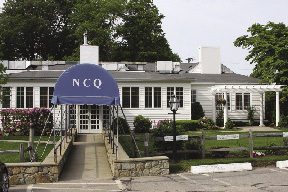One thing has remained constant through all the years and all of the changes that have taken place at the Neighborhood Club of Quincy and it is the significant role that the Neighborhood Club plays in preserving one of Quincy's most precious assets, its historic neighborhood. This unique and grand place brings people together to form a friendly, caring community and provides an elegant venue for members and private parties to celebrate special occasions.
The architect for the Neighborhood Club building was George Shepard (Shepard & Stearns 1921-1951) and the contractor was the popular, Edward Sears. Built in 1917, in a Colonial Revival style, it was intended to be a private organization, "formed for the purpose of maintaining a club for social, dramatic, athletic and civic activities." Circumstances changed its purpose when in 1918 the club was abruptly converted into a temporary hospital to cope with the Spanish influenza epidemic and during World War II was frequently used by Bethlehem Steel Co. in connection with its shipbuilding activities. The Neighborhood Club has been host to receptions for many member and non member business, religious, political and military leaders, both local and nationally.
Recently, members of the Neighborhood Club, Stephen Wessling president/CEO of Wessling Architects and Frank Trainor, president/CEO of Commonwealth Building, Inc., provided their expertise to help preserve and enhance the Neighborhood Club.
The following is a detailed account of the extensive work completed on the roof and other recent upgrades made to this wonderful facility. The club qualified for a $12,000 energy credit for the upgraded roof insulation and coupled with the other improves will also result in ongoing savings in heating and air condition costs.
The existing flat roof above the members' dining room, the Sears Room, the living room and the ballroom experienced leaks. As the roof leaked the acoustic ceiling tiles would get wet, sag and become stained. The original flat roof was constructed without ventilation. The lack of roof ventilation, insulation and a continuous vapor barrier accelerated the deterioration of the rubber roof membrane.
The roofs on the club were a combination of flat rubber roof membranes and steep slope asphalt shingles. The asphalt shingles had started to fail in some areas, especially in the valleys behind the mechanical equipment. The sloped roofs had various types of attic ventilation but none of them appeared to function properly because of where they were located. There were roof vents and flue pipes that were no longer being used. These items allowed the heated air to escape in the winter and the warm summer air to infiltrate the attic. The insulation within the metal ductwork was wet because of failing seam seals. The ductwork was wrapped with a waterproof membrane and insulation to solve the problem.
In December, RCH Roofing removed and replaced the majority of the roofing materials. All of the roofs that were replaced had high R-value rigid insulation installed, which significantly improved the heat lose and heat gain of the roofs. The roof passed its final inspection.
In addition to the roof problems the dormer windows were installed too low making it impossible to install proper flashing. The large round ductwork through the dormer window needed additional flashing. The dormer vinyl siding was removed; the unnecessary windows were removed and infilled with wood framing and insulation. One new window was installed with proper height under the windowsill to allow waterproof flashing.
Repairs were also made to the brick masonry chimneys, including new caps and the flashing at the roof.
The emphasis throughout the project was on sustainability, energy, preservation, comfort and safety. All were attained and contributed to preserving the Neighborhood Club for generations to come.
Joan Costello is the director of marketing and human resources for Wessling Architects in Quincy, Mass.
Tags:
Preserving the neighborhood by preserving the Neighborhood Club
June 14, 2012 - Construction Design & Engineering
 (1).jpg)









.png)